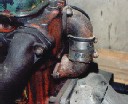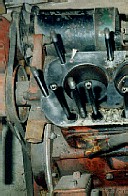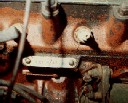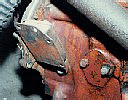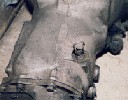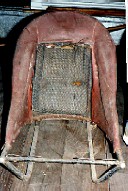Click on a photo to enlarge Engine and Drivetrain Probably the single most unique feature of GHD 100149 is it's engine, in 1959 and '60 the team cars were Twin Cams that used modified production engines, but the 1961 and '62 team cars used a special block casting that was totally different than the production engine. The engine number is EX178/43 and it's block has no water passages on the deck nor does it have any capacity designation on the left front of the block like all other BMC 'B' series engines. The cylinder head casting is also without water passages and the six large casting core holes are plugged which enabled the engine to be assembled without a headgasket. All water passes from the rear freeze out plug of the block up to a hole drilled in the rear of the head via an external pipe. The 1955 LeMans prototypes used this type of engine as did some of the engines built for use at record breaking at Bonneville, other than that I know of no other engines built this way. The bottom end of the engine is a 1622 nitrided crankshaft with Twin Cam rods and flat top pistons, the bore however is 1588. The cam was supplied by Piper and is designated a 714 grind with approximately a 268 degree duration, which is very mild by today's standards. The cylinder head has been ported and polished and the rocker shaft is supported at each end by a pair of brackets. The only passage between block and head is for oil and there is a relief cut for a rubber O ring. To prevent the head from moving horizontally there is also a dowel pin that located the head ( white arrow in photo). A pair of SU H6 1 3/4" carbs with ram pipes were used with an AEH 200 manifold. A special centrifugcal advance distributor was provided by Lucas as was a generator that has ball bearings instead of bushings. A Twin Cam flywheel and a competition clutch were employed. Like the 1955 LeMans engines, all of the freeze out plugs have been secured with a bar and safety wire. Almost every fitting on the engine including the cylinder head nuts have been cross drilled and safety wired. A blanking sleeve replaced the thermostat and no fan was fitted. The stock radiator was replaced by one with a 1/2" thicker core and an oil cooler was used with all connections cross drilled and safety wired. The gearbox utilized a close ratio gear set and the case is the Twin Cam style. The dip stick has been modified to make it easier to grasp through the large rectangular door in the alloy tunnel. A stock drive shaft connects it to 4.55 final drive that looks standard externally but inside is a ZF limited slip gear carrier. The connection for the check straps to the housing have been modified to increase rear axle travel about 1". The brake lines that run across the axle housing are covered with rubber tubbing to protect them from track debris. |
Interior and Electrical Details One of the first items to catch your eye is the 16" woodrim steering wheel. Though similar, this is not the same wood wheel that was optional on the production car. It has a laminated and riveted rim and the same wheel is found on the #44 car confirming that this is original. Just beyond is the instrument panel which has been altered to permit the fitting of a larger 5" Smiths 0-8000 RPM Chronometric telltale tachometer. At some time the original black vinyde dash covering was replaced with white vinyl. The Speedometer is correctly geared for the 4.55 final drive and shows a mere 29,251 miles. All of the switches have been moved to the left side of the panel away from the wheel and an accessory panel has been added in the speaker opening where there is an on/off toggle switch ( the keyed ignition switch has been added ) and a push button starter. There are also a pair of switches for each driving lamp. Just below that panel are the controls for directing the air from the cowl vent either on the drivers feet or up to the windscreen. An additional switch placed on the cowl facing straight up just to the right of the steering wheel which was used for the roof recognition light. The seats are Microcell racing buckets which were red with a black and white checked fabric on the seating surfaces. Black carpet covered the tunnel, and there was an armrest. On my car there is evidence that black rail carpets may have been used but not floor carpets. There appears to have been plain black door panels and roadster kick panels. |
Photo by Ian Prior |

